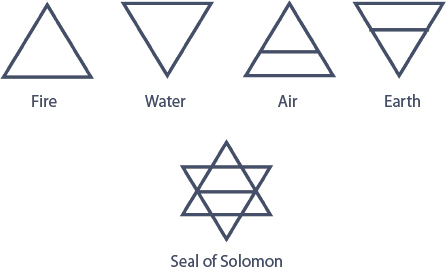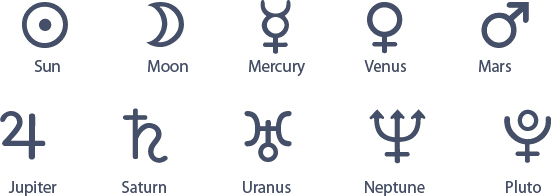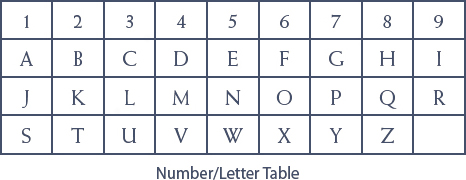
An idea, in the highest sense of that word, cannot be conveyed but by a symbol.
—SAMUEL TAYLOR COLERIDGE
Symbols speak to us at an unconscious level, evoking truths, archetypes, emotions, and spiritual qualities that lie at the core of our psyches and may not be understood by the conscious mind. As a result, the impact symbols have on us is often quite profound, triggering deep, complex feelings that we may not be able to comprehend or explain. Observe, for example, how patriotic people respond to their nation's flag, how religious groups advance ideas through the imagery of their faith, or how the Nazis reacted to the swastika. People in positions of authority and those who seek material gain understand the power symbols play in our daily lives, and they often use symbols to manipulate our unconscious responses for their own benefit.
We perceive symbols in collective ways as well as personal ones. Many symbols are universal, appearing in the art and artifacts of numerous cultures from different times and places. The spiral, which represents life energy, is one such symbol. In addition, each of us has a set of individual symbols that have special meanings for us alone. For me, cats signify creativity, although they may represent independence, grace, playfulness, or mystery to someone else.
Symbols aren't just handy shortcuts, like the icons for gas stations and restaurants that we see on highway signs. They express the essential nature or quality of something because they also embody its essence. Historically, symbols offered one meaning for the masses and another, deeper meaning for initiates. The Star of David is a good example. Most people associate the six-pointed star with the Jewish faith. But at another level, it depicts the union of matter and spirit through the intersection of a downward-pointing triangle (symbol of the feminine) and an upward-pointing triangle (symbol of the masculine).
Not only can we draw symbols on paper or another surface, we can also enact them physically. Sufi dervishes do that when they dance. Magicians illustrate symbols with their bodies, movements, and tools when they perform rituals. When a yogi practices mudras or a Catholic makes the sign of the cross, that person is gesturing with symbols. The ancient Celtic alphabet known as Ogham uses symbols derived from trees as letter equivalents, which can be signed as well as written.
Symbols can serve as a bridge, allowing us to make a connection with something intangible in order to incorporate it into our lives. For this reason, they play a major role in the practice of magick. When we employ symbols, we draw upon the energy of whatever they represent so we can use it for our purposes. We can also design our own symbols and project our intentions through them, which is what artists do when they create.
Numbers are probably our most common and frequently utilized symbols; they're so much a part of our everyday lives that we rarely think of them as symbols. Although we primarily use numbers as units of measurement, to represent quantities, they also have mystical qualities that can be tapped in magickal and spiritual work. According to Rudolf Steiner in Occult Signs and Symbols, “Those who deepen themselves in what is called in the Pythagorean sense ‘the study of numbers’ will learn through this symbolism of numbers to understand life and the world.”
In numerology, each number possesses a unique vibration. Numbers correspond to the signs of the zodiac and the houses of an astrological chart, the sephiroth of the Kabbalah's Tree of Life, the cards in the tarot, the hexagrams in the I Ching, and many other mystical systems. The basic meanings of the numbers in some Western traditions are as follows:
0: wholeness, unity
1: beginnings, raw energy, individualization
2: relationship, polarity, complementary energies, balance
3: self-expression, expansion, creativity
4: stability, structure, form
5: change, freedom, instability
6: give-and-take, community, balance, beauty
7: rest, retreat, introspection
8: manifestation, material power, strength
9: completion, bridging the material and spiritual realms
11: inspiration, humanitarianism, universal truths
22: spiritual power, mastery, wisdom
Numbers are important in magick work because they embody energetic qualities. You can tap their energy to enhance spells, rituals, and other practices. For example, if you are doing a love spell, you might want to incorporate the number two—the number of partnership—into your spell. You could do this in a variety of ways:
You can bring number symbolism into any spell. The number eight, for example, signifies order in the mundane world; we see this expressed in the eight holidays that comprise the Wheel of the Year, as discussed in Chapter 9. The number three represents the three dimensions of the physical world. This creative number is often used in spells to bring ideas to fruition in the material realm. Magicians may repeat an affirmation three times to empower, secure, and bind an intention. Wiccans believe that whatever a person executes magickally—by thought, word, or deed—returns to him or her threefold.
The numbers in your birthdate hold symbolic value, from the perspective of numerology. Add the numbers in the date to determine what's known as your “life lesson number.” In her book Numerology and Your Future, Dusty Bunker explains this “reveals your reason for being here, your purpose in life, and what you have chosen to learn in this incarnation.”
For example, if you were born on February 3, 1990, you would add the following numbers:
2 (for the month) + 3 (for the date) + 1 + 9 + 9 + 0 (for the year) = 24
Add the sum and reduce to a single digit: 2 + 4 = 6
Your life lesson number is 6, which numerologists associate with give-and-take, community, balance, and beauty. In this lifetime, you'll likely seek balance and harmony in all you do. Put emphasis on your home, family, and community; express your love of art and beauty; and nurture others by sharing your love.
Alchemy uses triangles as symbols for the four elements. Upward-pointing triangles, which reach toward the heavens and spirit, represent the masculine elements, fire and air. Downward-pointing triangles, which aim toward the earth and matter, represent the feminine elements, water and earth. The symbols for air and earth include a horizontal line through the center of the triangle. When the “male” and “female” triangles intersect, we see a geometric depiction of the union of these two energies, the merger of spirit with matter to produce life. You'll notice the figure we call Solomon's seal incorporates the symbols for all four elements.

The ancient Greek philosopher Plato associated the four elements with solid, geometric forms known as the platonic solids. According to him, the cube symbolized the earth element, the tetrahedron represented fire, the octahedron corresponded to air, and the icosahedron (which has sixteen triangular sides) related to water. The dodecahedron symbolized the universe; its twelve-sided surface is composed of twelve pentagons, which signify the twelve signs of the zodiac.
Sacred buildings and sites, religious art, and power objects often incorporate symbols of the heavenly bodies as a way of petitioning the gods and goddesses. In his book Sacred Architecture, A.T. Mann writes, “Each deity was associated with a particular planetary body … To evoke the god, one had to create manifestations of the cycle or numbers associated with the related luminary, planet or star.”
All the symbols for the planets contain circles or partial circles (arcs), usually in connection with crosses. Circles represent the heavens—the sun, the full moon, the planets, and our solar system. Self-contained and unending, the circle signifies life and promise, wholeness, unity, continuity, and eternity. The cross depicts the union of spirit and matter. The vertical line suggests movement upward toward the heavens, spirit, and masculine energy. The horizontal line represents the earth, matter, and feminine energy. Their connection symbolizes the merger that produces life, the blending of cosmic and earthly forces, the Divine working through matter.

By looking at the astrological glyphs themselves, we can discern clues to utilizing the planets’ energies in our lives. For example, the sun's symbol is a circle, representing the Divine, with a dot inside, which signifies the individual. This image tells us that expressing the sun's nature involves tapping the radiant, life-giving force of this heavenly body and focusing its creative power through the self. The moon's glyph is a crescent or partial circle. This suggests the moon requires something else to complete it—in astronomical terms, the sun's light. Indeed, the moon in your birth chart describes interpersonal interactions and plays a key role in your relationships with other people.
The horoscope pattern is a circle (symbol of wholeness and the Divine) divided by the cross of the angles (signifying matter and the physical realm). Within this, the aspects or relationships between the planets echo the essential natures of the numerological and geometric forms that comprise them. For instance, oppositions (two planets positioned opposite each other in the horoscope wheel, approximately 180 degrees apart) signify polarity and relate to the number two. Trines (two or more planets and/or energetic points configured such that each is positioned approximately 120 degrees away from the others) form a triangle in the horoscope's 360-degree circle, representing creative potential and the number three.
In spellwork and rituals, you can tune in to the power of these symbols in many ways:
A great deal of research has been done into the psychology of color and how we react mentally, emotionally, and physically to perceiving various hues. Studies have demonstrated that warm colors (red, orange) excite us and can actually increase heart rate, temperature, and respiration, whereas cool colors (blue, green) calm us and slow our bodily responses.
Chromotherapy, the art of healing with color, works by stimulating the brain (usually with colored light) to balance deficiencies or excesses and promote well-being. Rudolf Steiner, the founder of the Waldorf Schools, designed hospitals with different-colored rooms; patients were moved from room to room as their medical conditions changed. Similarly, magicians who perform healing work often project colors via imagination to aid an ailing subject.
Swiss psychiatrist Max Lüscher found that our color preferences reveal a great deal about our personality traits and disorders. First introduced in 1947, the Lüscher Color Test showed that test subjects whose favorite color was dark blue wanted emotional tranquility and a calm, orderly environment. Those who liked yellow best were restless, ambitious types who sought freedom and change, and hoped for better times.
Color plays an important symbolic role in the imagery on tarot cards. Many tarot artists associate the suit of wands with red, cups with blue, pentacles with green, and swords with yellow. We see color used in religious, magickal, and secular art to convey subtle messages to the viewer. Certain colors are also linked with the seven chakras, the four directions, the four elements, and the astrological signs.
Wearing particular colors can help you modulate your own energies or project a desired image to other people. Black, which symbolizes wholeness because it combines all hues (in paint or dye), is a favorite of Wiccans. When performing spells or rituals, you may choose to wear colors that correspond to the nature of the magick you're doing. This can help you focus your mental and emotional energy to enhance the power of your work.
Leonardo da Vinci saw colors as representations of the four elements, as we discussed in Chapter 4. Astrologers link colors with the zodiac signs and the planets as well. Red, for example, is a hot, dynamic, energizing hue whose vibration is akin to the fiery nature of Aries. Dark blue, the color of the ocean, relates to the water sign Pisces.
Magick practitioners frequently utilize color in spellwork to align themselves with the qualities of certain colors and to infuse energy into their spells. Keep the following color correspondences in mind when you're choosing ingredients for your spells:
Sun: yellow, gold
Moon: silver, white
Mercury: light blue
Mars: red
Jupiter: orange
Saturn: black, gray
Uranus: cobalt blue
Neptune: indigo, violet
Pluto: black, maroon
Aries: red, orange
Taurus: green
Gemini: pale blue
Cancer: white, silver
Leo: bright yellow, gold
Virgo: ocher, olive green, light brown
Libra: pink, peach
Scorpio: black, maroon
Sagittarius: orange, gold
Capricorn: navy, black, gray
Aquarius: cobalt blue
Pisces: purple, indigo
CANDLE SPELL FOR A PLEASANT TRIP
This easy spell relies on the symbolism of color and astrology. Perform it when the moon is in Sagittarius (the sign astrologers connect with travel).
You'll need:
Smudge the space where you'll cast your spell—preferably by burning sage—to cleanse it of any unwanted energies. Then cast a circle.
Lay the map or picture face up on your altar or another flat surface where the candle can burn safely.
Use the pen or nail to inscribe the astrological symbol for Sagittarius on the candle:

Fit the candle in the holder, set it on the map or picture, and light the candle. While you gaze into the flame, envision yourself in the place you plan to visit. Imagine yourself having a wonderful time. Make your visualization as detailed and rich as possible: witness yourself seeing the sights, eating delicious food, enjoying the company of friends. Spend as long as you like imagining your trip. When you feel ready, open the circle and allow your magick to flow out into the manifest world.
Allow the candle to burn down completely.
Candles offer one of the easiest ways to incorporate colors into spells and rituals, and magick workers generally keep several on hand in a variety of hues. If you're doing a spell to attract love, for instance, burn pink candles; for a prosperity spell, burn green or gold candles. When creating talismans and amulets, use pouches in astrologically appropriate colors to hold magick ingredients. Choose crystals and gemstones in colors that represent your intention, such as rose quartz for love spells or green jade to attract abundance. You might also wish to drape your altar with a cloth of an appropriate color while performing a spell or ritual, and on it place flowers that correspond to your purpose.
A magick square is an ancient configuration of smaller numbered squares arranged in rows and columns in such a way that the numbers in each column and row add up to the same sum. Called kamea in Hebrew, these squares possess magickal properties that can be used in spellwork.
Many kinds of magick squares exist. The ones shown on pages 140–141 correspond to the sun, the moon, and the five planets that can be seen from earth with the naked eye. These squares embody the energies of the celestial bodies and can be used to attract cosmic forces for magickal purposes.
One way to tap the power of a planet or luminary is to draw a sigil on a magick square that corresponds to the heavenly body. The word sigil comes from the Latin sigillum, meaning “sign.” Choose the magick square that relates to the planet that rules your intention. Let's say you want to develop inner strength. Astrologers consider strength a Saturnian quality, so work your spell on the magick square for Saturn.
Next, design a sigil from the word strength. First, you'll need to translate the letters in the word into their numerological values. In the study of numerology, which we've talked about briefly, each letter corresponds to a number.

The letters in strength translate this way:
1 2 9 5 5 7 2 8
S T R E N G T H
Next, lay a sheet of tracing paper over the magick square for Saturn.
Find the numbered square that corresponds to the numerological equivalent of your first letter (S = 1) and draw a small circle on the paper over the square. Then draw a line from that circle to the numbered square for the second letter value (T = 2), and so on until your design “spells out” the word.
If two letters side by side have the same numerological value (E, N = 5, 5), draw >< in the line where it crosses the box that contains that number.
Find the reduced sum of the letters in the complete word (39, which reduces to 3 by adding the digits 3 + 9 = 12 and then adding 1 + 2 = 3). Draw a small square in the line at that point. If you were using one of the larger magick squares, which include more numbered boxes, you'd put the small square in box 39.
Draw another small circle at the end of the line. This completes your sigil, the magickal symbol for strength.
You can display your symbol in a place where you'll see it often to reinforce your intention. Or carve it on a candle and burn the candle in a spell to release your intention into the cosmos. If you prefer, fold the paper and slip the sigil into a talisman or amulet pouch. You may want to draw appropriate astrological symbols, runes, or other images that signify strength for you on the reverse side of the paper sigil.